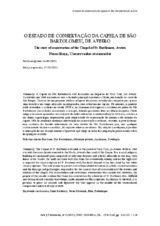Mostrar el registro sencillo del ítem
O estado de conservação da Capela de São Bartolomeu, de Aveiro
| dc.contributor.author | Roça, Nuno | |
| dc.date.accessioned | 2022-01-19T12:23:55Z | |
| dc.date.available | 2022-01-19T12:23:55Z | |
| dc.date.issued | 2021 | |
| dc.identifier.issn | 2530-0814 | |
| dc.identifier.uri | http://hdl.handle.net/10396/22351 | |
| dc.description.abstract | A Capela de São Bartolomeu está localizada na freguesia da Vera Cruz, em Aveiro. Construída em 1568 encontra-se com a fachada principal orientada a Norte, em direção ao canal de São Roque. Trata-se de um pequeno edifício religioso de planta centralizada composto por apenas uma divisão e um corpo adossado na retaguarda, com cobertura em cúpula. No interior, as paredes estão revestidas a azulejos do século XVII e, no altar-mor está exposta a escultura em pedra de São Bartolomeu com o diabo acorrentado a seus pés, ladeado por outras duas esculturas em pedra. Neste artigo procura-se apresentar um conjunto de dados referentes à contextualização histórica, artística e aos danos e patologias responsáveis pelo atual estado de conservação do interior e do exterior da capela. Não foi realizada nenhuma intervenção de conservação e restauro, contudo, o povo da beira-mar confirma ter havido intervenção de uma devota de São Bartolomeu que, sem qualquer conhecimento técnico e científico, fez repintes sobre as esculturas. Em relação à azulejaria, é peculiar a colocação de um azulejo isolado e figurativo que surge no meio da composição padronizada e fora de qualquer contexto. | es_ES |
| dc.description.abstract | The Chapel of St. Barttomy is located in the parish of Vera Cruz, in Aveiro. Built in 1568 it is with the main façade oriented to the North, towards the canal of São Roque. It is a small religious building of centralized plan composed of only one division and a body adossado in the rear, with dome cover. Inside, the walls are lined with tiles from the seventeenth century and on the high altar is exposed the stone sculpture of St. Bartlemy with the devil chained at his feet, lined by two other stone sculptures. This article aims to present a set of data related to historical, artistic contextualization and the damage and pathologies responsible for the current state of conservation of the interior and exterior of the chapel. No conservation and restoration intervention was carried out, however, the people of the seaside confirm that there was intervention by a devotee of St. Bartlomy who, without any technical and scientific knowledge, made repaints on the sculptures. In relation to tilework, it is peculiar to place an isolated and figurative tile that appears in the middle of the standardized composition and out of any context. | es_ES |
| dc.format.mimetype | application/pdf | es_ES |
| dc.language.iso | por | es_ES |
| dc.publisher | Asociación para la investigación de la Historia del Arte y del Patrimonio Cultural “Hurtado Izquierdo” | es_ES |
| dc.rights | http://creativecommons.org/licenses/by-nc-nd/4.0/es/ | es_ES |
| dc.source | Arte y Patrimonio 6, 116-132 (2021) | es_ES |
| dc.subject | Restauro | es_ES |
| dc.subject | São Bartolomeu | es_ES |
| dc.subject | Materiais pétreos | es_ES |
| dc.subject | Azulejaria | es_ES |
| dc.subject | Patologias | es_ES |
| dc.subject | Restoration | es_ES |
| dc.subject | Saint Bartlomy | es_ES |
| dc.subject | Stone materials | es_ES |
| dc.subject | Blue | es_ES |
| dc.subject | Pathologies | es_ES |
| dc.title | O estado de conservação da Capela de São Bartolomeu, de Aveiro | es_ES |
| dc.title.alternative | The state of conservation of the Chapel of St. Bartlomeu, Aveiro | es_ES |
| dc.type | info:eu-repo/semantics/article | es_ES |
| dc.relation.publisherversion | https://revistarteypatrimonio.wordpress.com/ | es_ES |
| dc.rights.accessRights | info:eu-repo/semantics/openAccess | es_ES |

